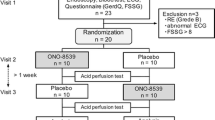Abstract
A muscarinic receptor subtype 1 (M1) antagonist, pirenzepine, recently has been shown to be relatively free of the usual anticholinergic side effects on esophageal smooth muscle and thus has been implicated for the treatment of gastroesophageal reflux disease (GERD). However, the effect of pirenzepine on GERD remains to be defined. Thirteen patients who demonstrated GERD in a baseline 24-hr ambulatory intraesophageal pH monitoring study were randomized in a double-blind crossover fashion to receive pirenzepine and placebo. An ambulatory 24-hr intraesophageal pH monitor was used to assess reduction in reflux (esophageal pH<4.0) with respect to position (upright vs supine), to total number of reflux episodes, and to episodes >5 min. A significant effect for pirenzepine was seen for episodes >5 min (t=2.61, P=0.023) and a trend towards significance was seen for total (upright and supine positions combined) percent time of reflux (t=2.13, P=0.055). Although not statistically significant, pirenzepine consistently showed greater reduction in all parameters of reflux tested. A greater reduction in percent time of reflux in supine vs upright positions (pirenzepine: 58.9% vs 21.4%; placebo: 43.6% vs 7.3%) may be clinically important in prevention of esophageal injury due to reflux in the recumbent position. Pirenzepine may provide a unique alternative for some GERD patients who may be refractory to other therapies of GERD.
Similar content being viewed by others
References
Goyal RK: Muscarinic receptor subtypes, physiology and clinical implications. N Engl J Med 321(15):1022–1028, 1989
Niemela S, Jaaskelainen T, Lehtola J, et al: Pirenzepine in the treatment of reflux oesophagitis, a placebo-controlled, double-blind study. Scand J Gastroenterol 21:1193–1199, 1986
Jaup BH, Abrahamsson H, Virtanen R, Iisalo E: Effective of pirenzepine compared with atropine andL-hyoscyamine on esophageal peristaltic activity in humans. Scand J Gastroenterol 17:233–239, 1982
Blackwell JN, Dalton CB, Castell DO: Oral pirenzepine does not affect esophageal pressure in man. Dig Dis Sci 31:230–235, 1986
Hassan M, Dalton CB, Castell JA, Castell DO: Pirenzepine and propanthline effects on esophageal pressure responses to bethanechol. Gastroeterology 81(5):334–338, 1986
Castell DO: Pirenzepine: A unique ‘anticholinergic’ on the esophagus.In Pirenzepine: New aspects in Research and Therapy. Sept 18, 1984. Proceedings. A Bettarello (ed). Amsterdam, Excerpta Medica, 1985, pp 142–149
DeVault KR, Castell DO: Effects of antireflux therapies on salivary function in normal humans. Dig Dis Sci 32(6):603–608, 1987
Jaup BH, Stockbrugger RW, Dotevall G: Comparison between the effect of pirenzepine andl-hyoscyamine in man. Scand J Gastroenterol 17(suppl 72):119–122, 1982
Ward BW, Wu WC, Richter JE, Lui KW, Castell DO: Ambulatory 24-hr esophageal pH monitoring. J Clin Gastroenterol 8 (suppl 1):59–67, 1986
Huynh H, Feldt LS: Estimation of the box correlation for degrees of freedom from sample data in the randomized block and split plot designs J Educ Stat 1:69–82, 1976
Bettarello A, Tuttle SG, Grossman MI: Effect of automatic drugs on gastroesophageal reflux. Gastroenterology 39:340–346, 1960
Hammer R, Berrie CP, Birdsall NJM, Burgen ASV, Hulme EC: Pirenzepine distinguishes between subclasses of muscarinic receptors. Nature 283:90–92, 1980
Carmine AA, Brogden RN: Pirenzepine. A review of its pharmacodynamic and pharmacokinetic properties and therapeutic efficacy in peptic ulcer disease and other allied diseases. Drugs 30(2):85–126, 1985
Henry DA, Hawkey C, Somerville K, Burnham WR, Bell GD, Langman MJS: Pirenzapine and cimetidine in duodenal ulcer: A comparative study.In 7th World Congress of Gastroenterology Proceedings. G Dotevall (ed). Stockholm, Sweden, Excerpta Medica, 1982, pp 214–216
Brown SG, Gomes M, Pounder RE, Rampton DS, Salmon PR, Sarner M, Vicary FR: Comparison of pirenzepine and cimetidine in gastric ulcer.In 7th World Congress of Gastroenterology Proceedings. G Dotevall (ed). Stockholm, Sweden, Excerpta Medica, 1982, pp 219–222
Vezzadini P, Sternini P, Valentini PL, Botti C, Lugli C, Labo G: Comparison of relapse rates in duodenal ulcer patients treated with pirenzepine or cimetidine.In 7th World Congress of Gastroenterology proceedings G Dotevall (ed). Stockholm, Sweden, Excerpta Medica, 1982, pp 238–245
Texter EC, Patel GK, Navab F, et al: Effect of oral pirenzepine, a muscarinic (M1) receptor antagonist, and oral atropine on lower esophageal sphincter pressure, esophageal manometry and scintiscans, and gut peptides. Clin Res 31:766A, 1983
Toussaint J, Van der Veken J, Cremer M: A comparative double blind trial of pirenzepine and propantheline in duodenal ulcerIn 7th World Congress of Gastroenterology Proceedings, G Dotevall (ed). Stockholm, Sweden, Excerpta Medica, 1982, pp 223–231
Talley NJ, McNeil D, Hayden A, Piper DW: Randomized, double-blind, placebo controlled crossover trial of cimetidine and pirenzepine in nonulcer dyspepsia. Gastroenterology 91:149–156, 1986
Helm JF: Effect of esophageal emptying and saliva on clearance of acid from the esophagus. N Engl J Med 310(5):284–288, 1984
Stockbrugger RW, Armbrecht U, Reul W: The effect of the M1-selective telenzepine on esophageal acid exposure in healthy volunteers. Z Gastroenterol 26(6):297–302, 1988
Geller LI, Griaznova MV, Petrenko VF, Bessonova GA: The degree of gastroesophageal reflux during treatment of the exacerbation of duodenal peptic ulcer by various drugs. Ter Arkh 60(2):42–43, 1980
Author information
Authors and Affiliations
Additional information
This study was supported by a grant from Boehringer Ingelheim Pharmaceutical, Inc., Ridgefield, Connecticut 06877.
Rights and permissions
About this article
Cite this article
Sato, T.L., Wu, W.C. & Castell, D.O. Randomized, double-blind, placebo-controlled crossover trial of pirenzepine in patients with gastroesophageal reflux. Digest Dis Sci 37, 297–302 (1992). https://doi.org/10.1007/BF01308187
Received:
Revised:
Accepted:
Issue Date:
DOI: https://doi.org/10.1007/BF01308187




